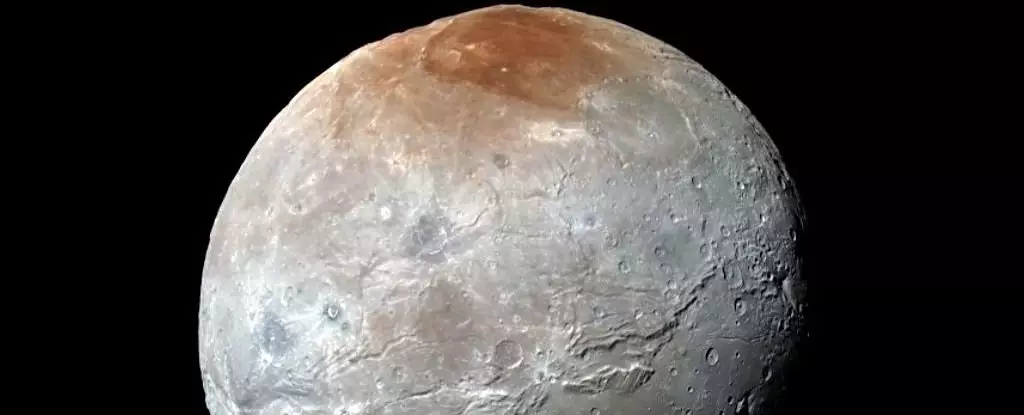Nestled in the frigid expanse of our Solar System, 5.7 billion kilometers from the Sun, lies Pluto, the renowned dwarf planet. Among its intriguing companions is Charon, Pluto’s largest moon, which bears striking resemblances to its parent body. Charon is not merely a satellite; it represents a fascinating binary system with Pluto, where both celestial bodies orbit a shared center of mass. This unusual dynamic distinguishes Charon’s relationship with Pluto from the more typical Moon-Earth model. With a diameter of a little over 1,200 kilometers, Charon is approximately half the size of Pluto, making it the most significant satellite in relative size within our Solar System.
In 1978, astronomers unveiled Charon, a discovery that stemmed from investigations into Pluto’s orbital mechanics. Approximately one-third the diameter of Earth’s Moon, Charon’s dimensions contribute to Pluto’s classification as a dwarf planet. This categorization is primarily due to Pluto’s inability to clear its orbital zone—evidence of which can be found in its harmonious dance with Charon. In 2015, NASA’s New Horizons mission made history by being the first spacecraft to traverse the vicinity of Pluto and its moons, marking a pivotal moment in our understanding of these distant worlds. The data collected revealed a rich tapestry of surface features, including ice formations, craters, and potential cryovolcanoes—indications of geological activity driven by subsurface processes.
Recent advances in research have been bolstered by the capabilities of the James Webb Space Telescope (JWST), which launched in 2021. With a powerful six-and-a-half-meter mirror designed to detect infrared light beyond the capacity of conventional telescopes, the JWST is uniquely equipped to unravel the chemical mysteries of distant celestial bodies. In a groundbreaking study, astronomers, led by Silvia Protopapa, utilized the JWST to uncover the presence of carbon dioxide and hydrogen peroxide on Charon’s surface. These findings are not merely academic; they are essential pieces of a larger puzzle that seeks to explain how external factors have shaped Charon, Pluto, and their interrelationships.
The chemical constituents of Charon reveal a world that bears striking differences from other Kuiper Belt objects dominated by nitrogen and methane ice. The detection of carbon dioxide, a significant molecule in planetary science, leads to deeper inquiries about the moon’s history and formation. Scientists hypothesize that these carbon-based compounds originate from beneath Charon’s icy crust, likely exposed by impacts from asteroids and other celestial objects that have punctuated its surface over billions of years. The analysis of the infrared light spectra collected from JWST offers unique “fingerprints” of these molecules, enabling researchers to infer the geological and astrophysical processes relevant to Charon’s development.
The origins of Charon remain an intriguing enigma within planetary science. Several theories suggest it formed through processes akin to those that created our Moon, hypothesizing that a massive collision in the Kuiper Belt dislodged a part of Pluto, leading to the creation of Charon. Alternatively, another possibility is that both Pluto and Charon emerged as separate entities, only to find themselves locked in a gravitational embrace following a collision. These theoretical frameworks underline the complexity of celestial mechanics and the interactions that characterize our Solar System’s formation.
The Broader Implications of Recent Discoveries
The identification of carbon dioxide and hydrogen peroxide on Charon holds significant implications beyond its immediate surroundings. Such insights can inform research about other trans-Neptunian objects, enhancing our understanding of their compositions and geologic histories. Each discovery acts as a marker in the vast timeline of our Solar System, allowing scientists to piece together a more comprehensive narrative of its evolution.
As technological advancements in astronomical observation continue to evolve, our comprehension of Charon and its relationship with Pluto will only deepen. The findings from the James Webb Space Telescope represent just the beginning of a more extensive exploration into the icy realms of our Solar System. Each data point enhances our understanding of these distant worlds, illuminating the peculiar characteristics that define them and offering a glimpse into the intricate processes that govern the cosmos. Charon remains an emblem of scientific curiosity and a testament to the ongoing quest to explore the unknown.


Leave a Reply